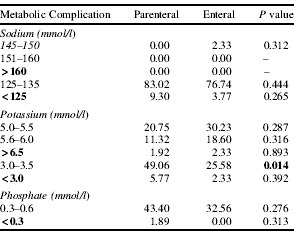Background: There is conflicting data on the recommended route of nutrition post-operatively following major gastrointestinal surgery(Reference Pacelli, Bossala, Papa, Sgadari and Doglietto1). Enteral nutrition has been associated with a lower infective complication rate(Reference Mazaki and Ebisawa2). Little however, is known on the relative frequency of metabolic complications following the introduction of nutrition after major surgery. Recent data has showed an incidence of 49% patients experiencing metabolic complications whilst on parenteral nutrition(3). We sought to compare aberrations in sodium, potassium and phosphate levels between those on parenteral and enteral nutrition following upper GI resections.
Methods: We went through theatre lists dating back to the formation of the upper GI surgery department in Glasgow selecting patients who had an upper GI resection and required post-operative nutrition. Data were collected using patients' notes from case notes, dietician records and electronic patient records. Data were subsequently analysed using the mini-tab statistical program. We collected the number and percentage of patients who had an abnormal blood result affecting sodium, potassium and phosphate whilst receiving feed and the patients' admission weight.

Results: We identified 116 patients from the period of Aug 2007 to Oct 2010. 66 patients received parenteral nutrition (TPN) and 50 enteral nutrition (EN), feeding jejunostomy (46) or nasojejunal feed (4). The table shows the percentage of patients who experienced a metabolic abnormality whilst receiving feed. The ranges in bold are considered clinically significant(Reference Weinsier and Butterworth4). The most common abnormality found was mild hyponatraemia (125–135 mmol/l), however this could be attributed to the acute phase and fluid retention. When considering clinically significant metabolic abnormalities alone, 13.21% of PN patients compared to only 6.98% of EN patients, P value 0.304, had an abnormality. Of all metabolic complications identified, only one differed significantly between PN and EN patients, a significantly higher incidence of hypokalaemia (3.0–3.5 mmol/l) in the PN group. There were no significant differences in duration of abnormalities. The mean admission weight of all patients was 79.05 kg.
Conclusions: There are significant biochemical changes following the introduction of parenteral and enteral nutrition after upper GI resection and this may be due to inappropriate nutritional replacement or the acute phase response. The only significant difference found between the PN with EN was the incidence of hypokalaemia (3.0–3.5 mmol/l) and may reflect inadequate parenteral replacement. The most common abnormalities found in both groups were hyponatraemia (125–135 mmol/l) and hypophosphataemia (0.3–0.6 mmol/l). As the admission weights suggest malnutrition was uncommon, we suggest that this is unlikely to represent clinical re-feeding syndrome and is rather a marker of the acute phase response.




